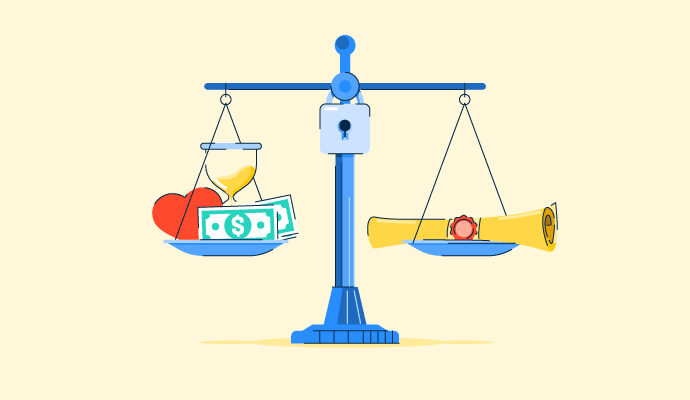
Whether you’re an employer or an employee, knowing your rights and how you’re protected is incredibly important.
From ensuring employees are paid a fair wage to employers knowing how to instill a safe working environment, it’s all part of employment law.
Employment laws govern the relationship between an employee and their employer, covering the rights and responsibilities of both parties. They include discrimination, family leave, wages, workplace safety, medical leave, and wrongful termination.
The goal of employment laws is to protect the rights of both the company and its employees. It also ensures all employees are treated equally, giving everyone a feeling of security. Since so many different state and federal laws go into this practice, understanding each helps employers and employees be sure of their rights.
Employers often use harassment prevention training software to monitor legal updates as existing laws change and new laws are created within the employment law space. These tools help deliver standard learning content to prevent a hostile work environment.
Companies of all shapes and sizes must understand employment law and employee rights. Typically, it’s up to the human resources (HR) and legal teams to put together materials that form an employee handbook. The handbook outlines how to treat all parties fairly and ethically. Some companies also have employment lawyers on staff who work as in-house counsel.
When both the employer and the employees understand their rights and obligations, they feel supported and better prepared in certain situations, like sexual harassment or salary misclassification. Employment law can also have a hand in dispute resolution between employees and management and in laying ground rules for safe working conditions.
“Part of what the legal team does is keep up with the latest updates and changes to labor and employment laws. We analyze the updates, assess how they apply, and implement the updates internally.”
Eunice Buhler
General Counsel, G2
It’s common to confuse employment law with labor law and vice versa, but the two have key differences.

Employment law refers to the legal issues that happen between an employer and their employees. It regulates this relationship while maintaining workplace compliance with these laws. It covers hiring practices, overtime pay, hours, and wages.
Labor law refers to issues involving union membership, union dues, and collective bargaining agreements. It’s a subset of employment law focused on the interactions between employers, workers, and labor unions.
Employment law is made up of regulations for all levels of government. Because it’s so extensive with a wide range of subject matters, it’s broken down into different areas of focus.
Discrimination at work happens when an individual within a protected class experiences different treatment than their coworkers or peers. Many kinds of discrimination can occur, and they’re all prohibited by law, ranging from state laws to decisions passed by the Supreme Court.
The following are a few terms and acts associated with employment law concerning employee discrimination.
Several employment laws cover compensation and benefits. In addition to ensuring employers pay their employees either an hourly wage or an annual salary, many companies also offer health and dental insurance, retirement plans, and paid time off. These are usually regulated by the National Labor Relations Board (NLRB).
The following are a few terms and acts associated with employment law concerning wages and employee benefits.
Employees have the right to feel safe at work and do their job free of hazards. With employment law, the government can hold employers responsible for certain workers’ compensation and medical costs if an employee is injured on the job.
The following are a few terms and acts associated with employment law concerning health and safety regulations.
Employees and those interviewing for jobs have certain rights and protection under employment law. While many are covered by federal laws, some states have implemented workplace laws for added protection against the most common causes of action.
The most common employee instances that result in violations of the Equal Employment Opportunity Commission (EEOC) employment law are:
Knowing the ins and outs of employment law is recommended for both employers and employees. From wages to workplace safety, knowing your rights and how you’re protected is always a smart choice.
Learn more about harassment prevention training, which states have mandated training and the benefits of training employees.
Disclaimer: This article is for information purposes only and isn’t meant to give legal advice. Always consult with an attorney for more information about a legal issue you may be experiencing.
This article was originally published in 2023. It has been updated with new information. robust
Mara Calvello is a Content and Communications Manager at G2. She received her Bachelor of Arts degree from Elmhurst College (now Elmhurst University). Mara writes customer marketing content, while also focusing on social media and communications for G2. She previously wrote content to support our G2 Tea newsletter, as well as categories on artificial intelligence, natural language understanding (NLU), AI code generation, synthetic data, and more. In her spare time, she's out exploring with her rescue dog Zeke or enjoying a good book.
What is wage garnishment? Wage garnishment is a legal procedure that occurs when a court...
 by Mara Calvello
by Mara Calvello
What are compensation statements? A compensation statement is a document showcasing an...
 by Mara Calvello
by Mara Calvello
You invest in your employees during the standard 9-5 workday.
 by Mara Calvello
by Mara Calvello
What is wage garnishment? Wage garnishment is a legal procedure that occurs when a court...
 by Mara Calvello
by Mara Calvello
What are compensation statements? A compensation statement is a document showcasing an...
 by Mara Calvello
by Mara Calvello


